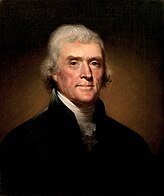Revolution of 1800
|
|
|||||||||||||||||||||||||||||
|---|---|---|---|---|---|---|---|---|---|---|---|---|---|---|---|---|---|---|---|---|---|---|---|---|---|---|---|---|---|
|
|||||||||||||||||||||||||||||
|
138 electoral votes of the Electoral College 70 electoral votes needed to win |
|||||||||||||||||||||||||||||
|
|||||||||||||||||||||||||||||

Presidential election results map. Green denotes states won by Jefferson, burnt orange denotes states won by Adams, and gray denotes non voting territories. Numbers indicate the number of electoral votes allotted to each state.
|
|||||||||||||||||||||||||||||
|
|||||||||||||||||||||||||||||
Thomas Jefferson
Democratic-Republican
The United States presidential election of 1800 was the fourth quadrennial presidential election. It was held from Friday, October 31 to Wednesday, December 3, 1800. In what is sometimes referred to as the "Revolution of 1800", Vice President Thomas Jefferson defeated President John Adams. The election was a realigning election that ushered in a generation of Democratic-Republican Party rule and the eventual demise of the Federalist Party in the First Party System. It was a long, bitter re-match of the 1796 election between the pro-French and pro-decentralization Democratic-Republicans under Jefferson and Aaron Burr and the incumbent Adams and Charles Pinckney's pro-British and pro-centralization Federalists. The chief political issues revolved around the fallout from the French Revolution, including opposition to the tax imposed by Congress to pay for the mobilization of the new army and the navy in the Quasi-War against France in 1798. The Alien and Sedition Acts, by which Federalists were trying to stifle dissent from Democratic-Republican newspaper editors, also proved to be highly controversial.
While the Democratic-Republicans were well organized at the state and local levels, the Federalists were disorganized and suffered a bitter split between their two major leaders, President Adams and Alexander Hamilton. The jockeying for electoral votes, regional divisions, and the propaganda smear campaigns created by both parties made the election recognizably modern.
...
Wikipedia


